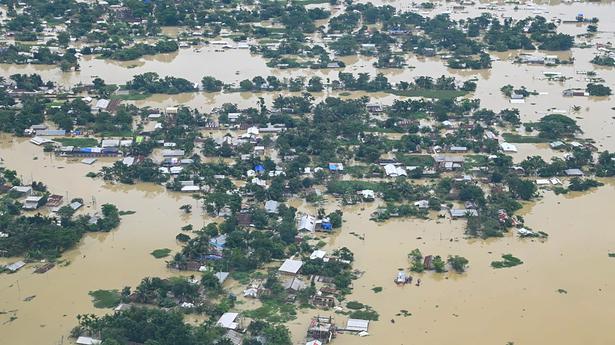
Explained | Assam’s annual tryst with devastating floods
The Hindu
Floods are an annual occurrence in Assam. In the ongoing wave, lakhs of people have been affected while 1.08 lakh hectares of crops have been damaged.
The story so far: The Brahmaputra Valley that encompasses the Northeast part of India witnesses floods almost every year, leaving behind a tale of death and destruction. Even before the onset of monsoon in Assam this year, incessant rain over the past week has wreaked havoc, with much of Assam submerged, crops destroyed and lakhs displaced.
By June 25, the death toll rose to 118 and the town of Silchar in Cachar district remained submerged for the sixth straight day, according to officials. The total population affected by the floods, however, declined to 33.03 lakh in 28 districts as against the previous day’s figure of 45.34 lakh in 30 districts, a bulletin issued by the Assam State Management Disaster Authority (ASDMA) said.
Nearly 2.7 lakh people, meanwhile, have been evacuated and moved to relief camps. This is the second time in less than a month that Assam has been ravaged by floods. At least 30 people were killed in the State due to floods in May.
So far, Assam has recorded an excess rainfall of 109 per cent in June. As per the meteorological department, the State has witnessed 528.5 millimetres of actual rainfall against the normal 252.8 millimetres. More than 5,000 villages and croplands have been inundated, with the Brahmaputra river breaching its embankments due to incessant rainfall. The river is presently flowing above the danger level at Dhubri, Goalpara, Guwahati, Tezpur,and Neamatighat.
Besides the Brahmaputra, rivers Beki, Manas, Pagladiya, Puthimari, Kopili, Subansiri are flowing above the danger level and Kopili is above the ‘highest flood level’ in Kampur area of central Assam’s Nagaon district. Urban areas of Barpeta, Cachar, Darrang, Goalpara, Kamrup (Metro), Karimganj, Nalbari and Udalguri are also under water.
Heavy rain has triggered landslides in Cachar, Dima-Hasao, Goalpara, Hailakandi, Kamrup (Metro) and Karimganj districts, throwing normal life out of gear. Road and rail services remain disrupted in several parts of the State. Food and potable water is not easily available. Roads and bridges have suffered serious damage.
The destruction is not limited to humans alone. Some 60,000 animals have been washed away and around 36 lakh were affected in the current wave of floods, according to the ASDMA report. More than 15 per cent of the Kaziranga National Park has been inundated with the Brahmaputra flowing above the danger level, an official statement noted. At least five animals, including a leopard, have been killed in floods in the national park so far this year.

“Writing, in general, is a very solitary process,” says Yauvanika Chopra, Associate Director at The New India Foundation (NIF), which, earlier this year, announced the 12th edition of its NIF Book Fellowships for research and scholarship about Indian history after Independence. While authors, in general, are built for it, it can still get very lonely, says Chopra, pointing out that the fellowship’s community support is as valuable as the monetary benefits it offers. “There is a solid community of NIF fellows, trustees, language experts, jury members, all of whom are incredibly competent,” she says. “They really help make authors feel supported from manuscript to publication, so you never feel like you’re struggling through isolation.”

Several principals of government and private schools in Delhi on Tuesday said the Directorate of Education (DoE) circular from a day earlier, directing schools to conduct classes in ‘hybrid’ mode, had caused confusion regarding day-to-day operations as they did not know how many students would return to school from Wednesday and how would teachers instruct in two modes — online and in person — at once. The DoE circular on Monday had also stated that the option to “exercise online mode of education, wherever available, shall vest with the students and their guardians”. Several schoolteachers also expressed confusion regarding the DoE order. A government schoolteacher said he was unsure of how to cope with the resumption of physical classes, given that the order directing government offices to ensure that 50% of the employees work from home is still in place. On Monday, the Commission for Air Quality Management in the National Capital Region and Adjoining Areas (CAQM) had, on the orders of the Supreme Court, directed schools in Delhi-NCR to shift classes to the hybrid mode, following which the DoE had issued the circular. The court had urged the Centre’s pollution watchdog to consider restarting physical classes due to many students missing out on the mid-day meals and lacking the necessary means to attend classes online. The CAQM had, on November 20, asked schools in Delhi-NCR to shift to the online mode of teaching.









